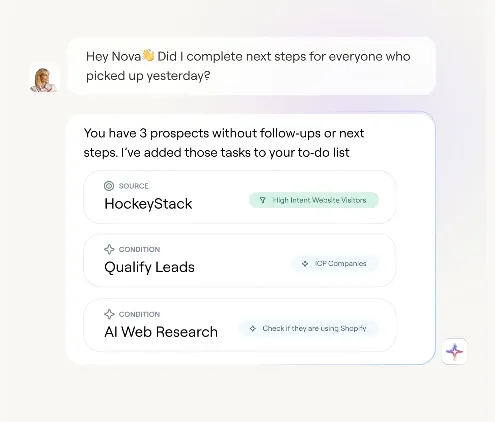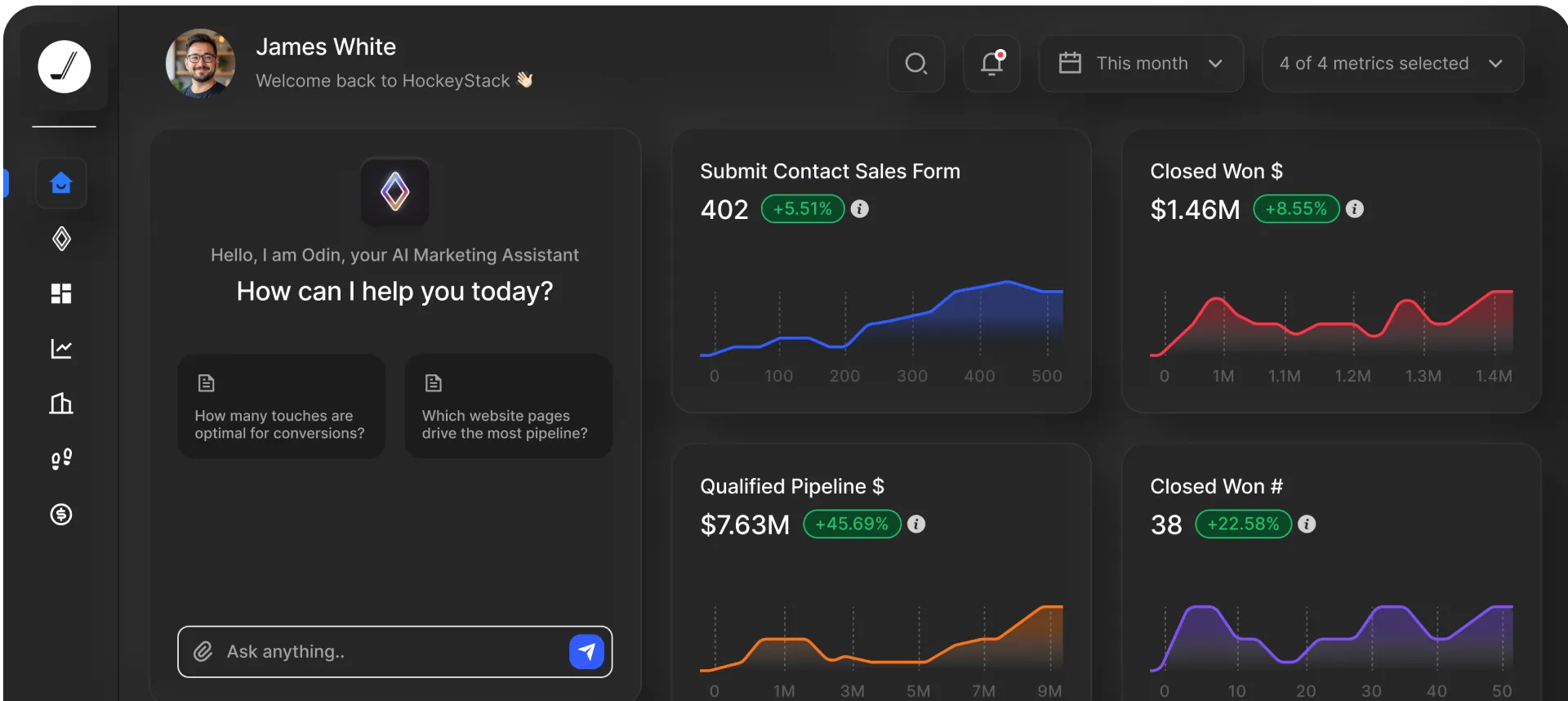What is GTM AI? The No-Nonsense Guide for Marketing & Sales Teams

What is GTM AI? The No-Nonsense Guide for Marketing & Sales Teams

Every other week, a new tool claims its "proprietary AI" will fix your GTM problems. But look closer and you’ll notice that most of these AI tools are just ChatGPT with a fresh coat of paint.
They'll help you write blog posts, summarize meetings, and maybe score some leads. But for go-to-market leaders, these AI features don't solve the real problems.
General-purpose AI bots like ChatGPT don't know your customers, can't access your CRM, and they definitely can't coordinate actions across your marketing automation, sales tools, and customer success platforms.
This has led to a new category called GTM AI — specialized AI that connects your entire revenue tech stack, analyzes patterns across all touchpoints to provide recommendations, and triggers automated workflows across departments to make your go-to-market process run smoothly.
Yes, 'GTM AI' sounds like next quarter's LinkedIn buzzword. But there's already a growing gap between companies that automate their GTM operations and those still coordinating through spreadsheets and Slack.
Below, we’ll walk you through what GTM AI really is, exactly how it works, and how to implement it without ripping out your entire tech stack.
What Exactly is GTM AI?
Before we define what GTM AI is, let's be clear about what it's NOT:
- A dashboard tool with better charts and an "AI insights" tab
- A chatbot that can query your CRM but can't tell you why deals are stalling
- Lead scoring that gives you numbers without explaining what to do with them
- Another tool that promises to "revolutionize your sales process" (spoiler: it doesn't)
We've seen plenty of tools slap "AI" on basic features and call it a day. That's not what we're talking about here. Here's how we define GTM AI at HockeyStack:
GTM AI is a specialized form of artificial intelligence that connects all your revenue data, understands the relationships between touchpoints, provides recommendations to optimize your GTM process, and automatically coordinates actions across teams.
So, while traditional AI tools optimize individual tasks, GTM AI treats your revenue process as one interconnected system.
📝Example: GTM AI might notice that deals from LinkedIn ads are taking 40% longer to close than deals from organic search. Instead of just reporting this as a metric, it analyzes the entire customer journey and discovers that LinkedIn prospects need more technical documentation before booking demos. It then recommends specific content creation changes and outlines which sales reps should prioritize these leads based on their technical expertise.
Common Misconceptions About GTM AI
Despite the growing interest in GTM AI, there's still a lot of confusion about what it actually does and who it's for.
Let's clear up the most common misconceptions we hear from revenue teams considering this technology:
- "It's just another marketing automation tool with AI sprinkled on top." → Marketing automation executes campaigns within a single channel. GTM AI connects your entire revenue ecosystem to understand how marketing, sales, and customer success work together.
- "GTM AI will replace our revenue teams." → GTM AI handles the mundane tasks so your team can focus on what matters. Sales reps spend less time updating records and more time talking to prospects. Marketers stop pulling reports and start building a strategy.
- "You need perfect data to get started." → GTM AI actually helps clean up messy data as it learns your business. It outlines gaps and inconsistencies across your tools, then standardizes the information automatically.
- "It's only for big enterprise companies." → Mid-market companies often get the most value because they have complex processes but no data teams. If you run campaigns across multiple channels and your sales cycle takes more than one touch, GTM AI helps.
- "GTM AI means replacing all your current tools." → The best GTM AI platforms work with what you already have. You keep your CRM, marketing tools, and everything else—GTM AI just connects them to show actionable insights you couldn't see before.
How GTM AI Works: Core Components and Capabilities
GTM AI operates through a continuous process that runs in the background of your revenue operations. It sounds complicated, but it's actually pretty straightforward.
GTM AI connects all your revenue data and integrates with every tool in your stack — CRM, ad platforms, website analytics, and customer success tools. It understands how each touchpoint relates to revenue outcomes and maps the complete customer journey.
- The problem: Your marketing automation shows email clicks, your CRM shows deal stages, and your ad platforms show impressions. But none connect to show which touchpoints drive revenue.
- How GTM AI solves it → Creates a unified customer journey that tracks every interaction from first touch to closed deal. It shows exactly which combinations of touchpoints lead to conversions.
GTM AI analyzes patterns across the entire funnel. With unified data, GTM AI outlines relationships that individual tools miss. It discovers why certain leads convert faster, which marketing touchpoints influence deal size, and what signals predict churn.
- The problem: You can see that the Q3 pipeline is down 15%, but you don't know if it's lead quality, market conditions, sales process issues, or something else entirely.
- How GTM AI solves it → Analyzes thousands of data points to pinpoint that leads from webinar campaigns are stalling because the follow-up sequence doesn't tackle technical questions that came up during the session.
GTM AI automates coordinated responses. When it spots a pattern (e.g., enterprise leads stall after demos), it can simultaneously alert sales reps, change the messaging, and update lead scoring criteria. You don’t need to worry about any manual coordination.
- The problem: Even when you find the root cause, fixing it requires coordinating changes across marketing, sales, and customer success. This usually takes weeks of meetings and follow-ups.
- How GTM AI solves it → Automatically updates webinar follow-up sequences, alerts sales reps to tackle technical concerns earlier, and adjusts lead scoring to prioritize technically-minded prospects.

This continuous loop is what makes GTM AI different from traditional tools that work in isolation. And here's how this changes the way revenue teams operate:

What this means for your team: No more hours spent diagnosing pipeline problems in weekly meetings. Marketing sees which campaigns drive high-value leads, sales focuses on prospects likely to convert, and customer success spots at-risk accounts before they churn.
The Payoff: The Benefits of Using AI in Your Go-To-Market Strategy
With GTM AI, your revenue process finally works as one system. Here's what changes specifically:
Increase Your GTM Efficiency and Speed
Sales teams everywhere are dealing with the same time-wasting problems. Here's how this enterprise rep at a successful SaaS company describes their workday:
"So much bullshit. Account plans. Prepping for deal reviews. Prepping for deep dives (different than deal reviews). Prepping for forecast meetings. So much time spent on internal nonsense. It’s hell. So curious if it’s like that at other companies. For context, I’m an enterprise rep at a very successful SaaS company."
Research from Salesforce even shows that sales teams spend 66% of their time on non-selling activities, but GTM AI automates much of that administrative overhead.
No more manual CRM updates, no more scrambling to prepare for meetings, and no more switching between tools to understand your prospects.
Boost Pipeline Quality and Predict Revenue
Most pipeline reviews are exercises in wishful thinking. Reps give updates based on their last conversation, managers try to read between the lines, and everyone pretends the forecast is reliable.
We’ve researched forums and subreddits, and sales leaders everywhere are feeling this frustration:

Gartner says that only 45% of sales managers are highly confident in their company’s forecasting accuracy. But now, GTM AI can show you exactly what's happening with your deals.
It tracks how prospects engage with your content, how long similar deals take to progress, and what behaviors signal a stalled opportunity. You can spot at-risk deals weeks before they fall apart.
💡PRO TIP: HockeyStack's Odin AI looks at your complete pipeline and tells you exactly why deals slow down. You get clear answers like "prospects from paid social need case studies before booking calls" or "enterprise deals stall when they don't get pricing context early.
Deliver Scalable Personalization and Finally Prove ROI
For years, personalization at scale seemed impossible. Generic AI tools couldn't understand your specific customers or business context, making most "personalized" outreach feel robotic.
This sales rep on Reddit nailed the problem:
"Personalisation at scale is an oxymoron.
If you want to succeed at personalisation, you need to be one step ahead of what AI offers. Otherwise you’re just making the same noise as 1000’s others."
This was true for general-purpose AI, but GTM AI is different.
Because it understands your customer journey and knows which touchpoints drive conversions, it can create personalization based on where prospects are in your specific sales process and what similar customers responded to.
McKinsey Research shows that companies that use advanced personalization have a competitive edge and can see 40% more revenue from marketing.
GTM AI also tackles the ROI tracking pain points that frustrate most marketing teams. You get clear revenue attribution across every touchpoint that shows exactly which campaigns contributed to closed deals.
Automate Workflows and Align Your Entire Team
Sales and marketing alignment sounds great in theory, but in practice, it often looks like this:
"Marketers believe salespeople are wasting their leads when they fail to convert, and salespeople want better leads from marketers.
It's a tale as old as time."
GTM AI breaks this cycle by automatically coordinating your teams. When a prospect shows buying signals, it automatically alerts sales, updates marketing campaigns, and adjusts lead scoring — all at the same time.
GTM AI in Action: Common Use Cases
GTM AI delivers the most value when it's solving specific, day-to-day problems that revenue teams face. Here are the most common ways teams use it:
- Stop deals from going cold: GTM AI notices when prospects stop responding and automatically sends the right follow-up AI content based on what worked for similar deals before.
- Route leads to the right reps: It figures out which salespeople close deals fastest for different types of prospects and sends new leads to them instead of just rotating randomly.
- See which specific campaigns work: You can finally track which marketing efforts really influence deals, not just the ones that get credit for the final click.
- Catch churn risks early: It flags customers who are showing warning signs based on how they use your product and interact with support, before it's too late to save them.
- Handle competitive threats: When prospects mention competitors or check out their websites, GTM AI automatically gives your team the right talking points and battle cards.
- Cross-sell opportunity detection: It identifies existing customers who match the profile of accounts that typically expand, along with the right timing and messaging.
- React fast when big prospects show interest: GTM AI automatically alerts your sales team and updates targeting when enterprise prospects hit your pricing page multiple times.
- Know the best time to reach out to prospects: GTM AI analyzes when similar customers respond and tells you the optimal days and times for outreach.
Learn more → What is Account-based Go-to-Market (GTM)?
Quick Reminder: Implementation Basics Still Apply ⚠️
You know the drill with new tools, but it's worth repeating — GTM AI implementations fail for the same reasons any tool does:
- Pick one problem first → Start with pipeline visibility or attribution, not both
- Don't wait for perfect data → GTM AI works with messy data and helps clean it up
- Get leadership buy-in early → Sales and marketing heads need to agree upfront
- Start with existing tools → Don't rip and replace your whole tech stack
- Define success metrics → Know what "working" looks like in 90 days
- Train your team gradually → Roll out to power users first, then expand
How to Choose a GTM AI Platform (and Avoid the Hype)
Every vendor now claims to do GTM AI, but most are just traditional tools with AI features bolted on. Here's how to spot the difference:
Does it Unify Your Entire GTM Stack, Not Just a Piece of It?
Why this matters: Most "GTM AI" tools are just upgraded versions of existing point AI solutions that can't see beyond their own data. Without full-stack integration, you're still stuck with the same siloed insights that miss the bigger revenue picture.
What to look for:
- Connects to all your major revenue tools — CRM, marketing analytics, ad platforms, customer success, and website analytics
- Maps complete customer journeys from first touch to renewal, not just individual touchpoints
- Shows relationships between marketing activities and sales outcomes across all channels
- Provides unified AI reporting so you don’t have to pull data from multiple dashboards
- Updates insights automatically when you add new tools or data sources
Red flags to avoid:
- Claims to be "GTM AI" but only integrates with 3-4 tools in your stack
- Focuses heavily on one function (like email marketing) with limited cross-platform insights
- Demands manual data exports or CSV uploads to connect different systems
- Platforms that require you to replace your existing tools to work properly
Is the AI a Real Analyst or Just a Fancy Calculator?
Why this matters: Many platforms slap "AI" on basic reporting features that just aggregate data and apply simple formulas. Real GTM AI should understand context, outline patterns humans would miss, and tell you what to do next based on thousands of similar situations.
What to look for:
- Explains why metrics changed, not just shows that they changed (e.g., "pipeline dropped because enterprise leads aren't getting technical content before demos")
- Spots non-obvious patterns across multiple data sources that individual tools can't detect
- Gives you specific advice that makes sense for your business and customer segments
- Understands industry context and seasonal patterns relevant to your market
- Predicts future outcomes with clear reasoning, not just statistical projections
Red flags to avoid:
- Only shows dashboards with charts, but doesn't explain what they mean for decision-makers
- Gives generic advice that could work for any company or startup
- Can't tell you why it made certain predictions or suggestions
Does it Automate Actions or Just Create Reports?
Why this matters: Reports tell you what happened after it's too late to do anything about it. Real GTM AI takes action automatically when it spots opportunities or risks. It coordinates responses across your revenue teams without manual intervention.
What to look for:
- Automatically alerts the right team members when specific conditions are met (e.g., enterprise prospects visit your pricing page three times in a week)
- Updates lead scoring, campaign targeting, and sales priorities based on new data without manual intervention
- Triggers coordinated workflows across multiple teams when it detects opportunities or problems
- Adjusts marketing campaigns and sales outreach based on what's working in real-time
- Automatically creates tasks, updates records, and schedules follow-ups based on prospect behavior
Red flags to avoid:
- Only provides recommendations that you have to act on manually
- You have to export data or copy insights into other systems to take action
- Focuses on reporting and analysis, but doesn't actually change anything in your workflow
- Makes you the middleman between insights and execution instead of automating the connection
💡PRO TIP: HockeyStack's Nova AI handles team coordination automatically. When a prospect downloads multiple case studies or attends a webinar, Nova alerts your sales rep, updates their lead score, and triggers relevant follow-up sequences across all your tools. Your team stays in sync without the constant Slack messages.

HockeyStack: The GTM AI Platform Built for a Unified Revenue Engine
GTM AI platforms that check all these boxes are rare. Most tools claim to be "GTM AI" but only solve part of the problem. You get stuck with the same disconnected insights and manual coordination you had before.
That's why we built HockeyStack. HockeyStack connects to your entire GTM tech stack and pulls data from marketing, sales, product, and customer experience.
Our AI agents (Odin and Nova) then analyze this data to outline pipeline problems and automatically coordinate responses across your teams. What used to take hours now takes minutes.
Here's more specifically how HockeyStack solves the real problems that modern GTM teams face:
Odin AI Analyst – Your On-Demand Revenue Intelligence
Odin is HockeyStack's AI analyst that answers complex revenue questions in plain English. You can ask about funnel trends, campaign performance, or social media results and get instant answers with visual insights.
Here's what Odin can do:
- Answer funnel and attribution questions about any campaign, channel, or time period
- Write logic-based reports and explain findings in plain language
- Recommend specific actions to improve your outcomes based on data patterns

No more waiting days for custom analysis or digging through multiple dashboards to piece together the story.
Custom Reporting That Answers Your Questions
HockeyStack's custom reporting lets you build reports the way your GTM motion actually works. You can filter by product, geo, channel, customer lifecycle personas, and more to get the exact view you need.

The platform supports multiple attribution models and funnel views, plus custom dimensions and lift reports for deep-dive comparisons.
You get pre-built templates to start immediately, but can customize everything to match your specific business model and reporting needs.
Automate GTM Workflows with Nova
HockeyStack's Nova AI automates your entire outbound motion from detecting buying intent to coordinating follow-up across teams.
Nova outlines high-intent prospects, performs AI web research to find relevant context, then automatically updates your CRM and triggers personalized outreach sequences.

The GTM workflows connect your whole GTM stack, from HubSpot and Salesforce to LinkedIn and email platforms.
Key workflow capabilities include:
- Cross-team coordination: Orchestrate workflows across tools and teams with zero manual effort so sales and marketing work from the same playbook.
- Automated prospecting: Automate every step from detecting buying intent to sequencing hyper-relevant messaging.
- Team alignment: Break down silos and align your entire GTM engine around shared prospect data and automated workflows.
Nova handles the coordination work that usually requires constant Slack messages and manual handoffs between teams.
Prove Marketing ROI with Multi-Touch Revenue Attribution
Most attribution tools give you either first-touch or last-touch data, which tells you almost nothing about your real customer journey.
HockeyStack's flexible attribution shows you the complete picture of how prospects interact with your marketing before they convert.

You can choose from multiple attribution models to understand what's really driving results:
- See which touchpoints contribute most to revenue with multi-touch models
- Use single-touch attribution for specific parts of your funnel where it makes sense
- Compare different attribution models side-by-side to get the full story
- Track both online and offline interactions in one unified view
Instead of arguing about whether your LinkedIn ads or content marketing deserves credit for a deal, you can see exactly how each touchpoint contributed. This means better budget decision-making and more accurate ROI calculations across your entire marketing mix.
Why GTM AI is the Future (and Why Waiting is Risky)
You've probably seen enough "AI-powered" marketing this year to last a lifetime. And we know you've heard "this time it's different" before.
But with GTM AI, the difference isn't the AI itself. It's that it’s finally tackling the coordination problems that kill deals and slow down most revenue teams.
Think about CRM adoption. Ten years ago, plenty of sales teams still tracked deals in spreadsheets. They said CRMs were too complicated. Now, those same arguments sound ridiculous. Every company uses a CRM because it's table stakes for running a sales team.
GTM AI is heading in the same direction. Companies using it now can see their complete customer journey, coordinate responses automatically, and spot problems before they hurt revenue. Teams without it are still manually pulling reports from five different tools and trying to figure out why pipeline dropped.
This is just a realistic overview of what’s happening. Competitors who adopt GTM AI will move faster and make better decisions. The ones who don't will keep dealing with the same data mess and coordination problems they have today.
You can keep spending hours every week pulling reports and trying to figure out what's working. Or you can let GTM AI handle that stuff so your team can focus on what drives revenue.
Curious how this would work with your messy data? Book a demo with HockeyStack and we'll show you.
FAQs
What makes HockeyStack’s approach to GTM AI unique?
Our approach is unique because we don't treat GTM AI as one generic feature. We built a complete command center for your entire revenue team.
Instead of a single AI, you get a team of specialized AI agents that handle different parts of your revops process.
Odin serves as your AI-driven strategist for marketing and leadership. It finds opportunities in your data and recommends specific actions to take.
Nova acts as your AI assistant for sales reps on the front lines. It handles the coordination and follow-up work that usually falls through the cracks.
This setup, combined with our GTM Workflows, creates a closed-loop system. Your marketing, sales, and customer success teams stay aligned without the constant meetings and manual handoffs that slow most revenue operations down.
How is a GTM AI platform different from a CDP or a Marketing Automation tool?
CDPs store customer data and marketing automation tools execute campaigns, but neither understands your complete revenue process.
GTM AI connects data across your entire tech stack (marketing, sales, and customer success), then analyzes relationships between touchpoints to show what drives deals.
It's the difference between having organized data versus having intelligent recommendations that drive revenue.
Will GTM AI replace our sales and marketing teams?
No, GTM AI makes your teams more effective, not obsolete. It handles the data work, pattern recognition, and coordination that currently eats up your team's time.
Your SDRs can focus on sales enablement and closing deals instead of updating CRM records. Marketers can focus on GTM strategy and creative work instead of pulling attribution reports.
Is GTM AI only for large enterprises?
Not at all. Mid-market companies often benefit the most because they have the complexity of multiple tools and channels but lack the resources for large data teams.
If you're running campaigns across multiple channels and your sales cycle is longer than a single touchpoint, GTM AI can help you understand what's working and coordinate your team's response.
This sounds complex. How much work is it to actually implement?
This isn't old-school enterprise software that takes six months and a team of engineers to set up. Modern GTM AI platforms are built with no-code integrations that can connect to your existing tech stack in hours.
With HockeyStack, for example, you can start seeing initial insights within a day or two, with the AI's recommendations becoming progressively smarter over the first few weeks.
Analyze LinkedIn Influence
In this episode of Marketing 201, you'll learn how to analyze LinkedIn Influence using HockeyStack.

More Blog Posts

Ready to see HockeyStack in action?
HockeyStack turns all of your online and offline GTM data into visual buyer journeys and dashboards, AI-powered recommendations, and the industry’s best-performing account and lead scoring.

Ready to See HockeyStack in Action?
HockeyStack turns all of your online and offline GTM data into visual buyer journeys and dashboards, AI-powered recommendations, and the industry’s best-performing account and lead scoring.




